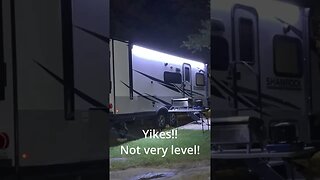Hasty Worst
In the engineering world, “over the fence” means providing a solution for a problem and handing the finished solution off to someone else to incorporate into the product. This skit showed the disadvantages of such an approach; safety researchers and engineers were so focused on addressing their own concerns that they failed to realize that their self-centered “solutions” are creating several more problems. Theirs was in essence a stovepipe mindset and not sound engineering (storming the gates of the software and engineering departments, seizing control of the food and water supplies and violently deposing the chief engineer didn’t help matters either).
A good example of the over the fence mindset is back-up beepers on construction equipment. Back-up beepers have been criticized in scientific literature as ineffective because the workers at the site become desensitized to the noise; sort of a modern day version of “The Boy Who Cried Wolf” (much in the same way that the public has become desensitized to car alarms). Furthermore, back-up beepers are very unpopular with the public because they are a source of noise pollution. For the public, the alerts are completely irrelevant; back-up beepers are designed to alert individuals that construction equipment is nearby. The public is not permitted on nor do they have any intention on walking onto a construction site, so the warnings have no bearing on them, yet they have to endure the noise every single day, which we here at CoBaD argue induces stress and adversely impacts quality of life, both of which play a significant part in one’s health. From an auditory perspective, the back-up beepers are harmful as well; the typical 1000 Hz pure tone beeps at between 97 and 112 decibels, exceeding the long-term hearing loss threshold of 70 decibels and the Occupational Safety and Health Administration's (OSHA) acceptable eight hour time weighted average maximum of 85 decibels. And when safety focals comically try to implement workarounds rather than admit they were wrong and fix the back-up beeper, it just makes matters worse (like in the skit when Donny Brook and Hugh Encry wore earplugs and NIESH broke in halfway through the skit and tried to fix the problem by introducing closed captioning).
The “dance music when in motion” safety feature is poking fun of scissor lift cranes. Scissor lift cranes are designed to make the same loud and annoying beep not only when they are backing up, but every time they are in motion (moving forward, raising payload and lowering payload). Based on anecdotal evidence, we think their alerts are in the same boat as back-up beepers, especially when those cranes are used indoors. Again, it seems that safety engineers just don’t seem to get it.
The LEAP blower, as you probably guessed, is a jet engine, and a jab at leaf blowers, yet another noise pollutant. The LEAP (Leading Edge Aviation Propulsion) is a 50-50 joint venture between GE Aviation and Safran Aircraft Engines. Specs for the “leaf blower” depicted in this skit were derived from the LEAP-1B model as equipped for Boeing’s 737 MAX.
It is easy to blame OSHA for the back-up beeper fiasco, as OSHA is responsible for inspecting and examining workplaces and enforcing safety and health rules. But the law is in the books; the Code of Federal Regulations Title 29, 1926.601(b)(4) states “No employer shall use any motor vehicle equipment having an obstructed view to the rear unless: (i) The vehicle has a reverse signal alarm audible above the surrounding noise level or (ii) The vehicle is backed up only when an observer signals that it is safe to do so.” However, if one “takes a look upstream,” we here at CoBaD think OSHA's “identical twin,” the National Institute for Occupational Safety and Health (NIOSH) should shoulder some of the blame as well (NIOSH and OSHA were both created under the OSHA Act of 1970). NIOSH is responsible for conducting research and recommendations in the field of occupational safety and health, and for providing recommendations for the prevention of work-related injury and illness. They should be aware first hand of all the contrary research and public criticism, yet it appears they are turning a deaf ear to all the outcry, apart from doling out the occasional earplug and caption. So it seems to us here at CoBaD that based on the above discussion, it is NIOSH that isn’t doing their job. So this skit is really poking fun at NIOSH’s “over the fence” scientists and researchers for the back-up beeper and the other over the top “safety features” depicted in this skit.
References:
Center for Disease Control and Prevention (2019). What Noises Cause Ear Loss? https://www.cdc.gov/nceh/hearing_loss/what_noises_cause_hearing_loss.html
Holzman, David C. (2011, January). Vehicle Motion Alarms: Necessity, Noise Pollution, or Both? Environmental Health Perspectives, 119(1), A30–A33. https://www.ncbi.nlm.nih.gov/pmc/articles/PMC3018517/
Wikipedia. Back-up beeper. https://en.wikipedia.org/wiki/Back-up_beeper
-
 13:58
13:58
Autorestomod and Manic Mechanic
2 years ago $0.01 earnedBest And Worst 351 Cleveland Heads
113 -
 5:18
5:18
DanDanTheFireman
3 years agoThis Is The Worst Road Rash I Have Seen In Years
4 -
 1:03
1:03
TrailerTravelin
10 months ago $0.01 earnedWorse Campsite Ever!! 😱
13 -
 16:45
16:45
DanDanTheFireman
2 years agoThe Worst Motorcycle Crash of 2021
27 -
 9:29
9:29
Humble Mechanic
3 years agoThe 4 WORST Project Car Words ~ While I'm In There
27 -
 0:03
0:03
DanDanTheFireman
2 years agoMy worst cornering fear
1 -
 5:50
5:50
DanDanTheFireman
3 years agoThe Second Worst Kind of Motorcycle Cornering Mistake
5 -
 17:05
17:05
DanDanTheFireman
2 years agoThe Worst Kind Of Motorcycle Crash
1 -
 1:29:27
1:29:27
Marfoogle News
1 year agoThe Worst is here!
1.27K2 -
 9:50
9:50
DanDanTheFireman
2 years agoNow THIS is the Worst Motorcycle Crash of 2021
3